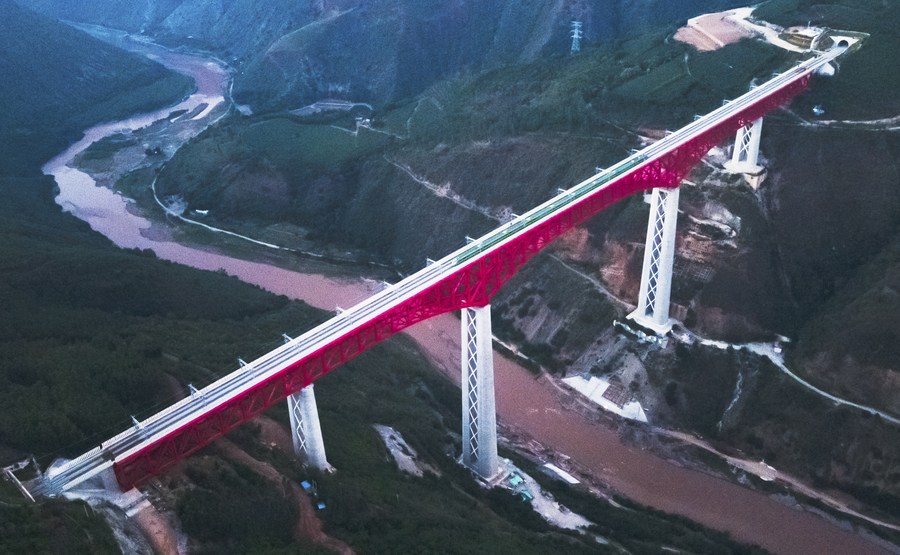China-Laos Railway, an engineering miracle that brings two neighbors closer
This year marks the 60th anniversary of the establishment of diplomatic relations between China and Laos. During the past 60 years, relations between the two countries have developed in various fields such as social, cultural, political and economic. The China-Laos Railway, which opened on the 3rd of this month, can be seen as a new approach to bilateral relations. This railway connects the hearts of the people of two friendly countries which are physically separated by land. This landmark project is an engineering miracle that brings two neighbors closer.

Aerial photo shows an electric multiple unit (EMU) train of the China-Laos Railway crossing a major bridge over the Yuanjiang River in southwest China's Yunnan Province, Dec. 3, 2021. (Xinhua/Wang Guansen)
This is the first railway project to be jointly implemented by China and Laos and built with Chinese investment, and which is directly connected to the Chinese railway network. The electrified passenger and freight train is designed to Chinese technical and management standards, and could be part of the Trans-Asian Rail Network, a grand scheme that connects China, Laos, Thailand, Malaysia and finally Singapore. It aims to create a combined rail network across Europe and Asia. The China-Laos Railway will also enable faster shipping to Europe, bypassing crowded maritime traffic in the Straits of Malacca.
Construction with huge difficulties
Laos is the only landlocked country in Southeast Asia, and has a population of 7.3 million. The China-Laos Railway, Belt and Road Initiative corresponds to the Lao government's strategy of transforming it from a landlocked country to a land-link hub. The route stretches 1,035 km from Kunming in China's Yunnan Province to the Lao capital Vientiane. It has reduced the travel time from Kunming to Vientiane to 10 hours.
The China-Laos Railway consists of two parts - the Chinese section and the Lao section. 47 percent of the railways run through 75 tunnels and 15 percent over 167 bridges. Along the way there are also deep valleys with mountains and complex geological conditions. Laos is known as the "roof of the Indochina Peninsula", with mountains and plateaus covering about 80 percent of the land area. Due to the mountains in northern Laos, the roads connecting the cities are not only winding, but also dangerous.
On Dec. 25, 2016, construction began in the northern Lao city Luang Prabang. Construction of the tunnel on this railway was not an easy task. The heat in Laos added to the difficulties involved in building the tunnel, which caused the temperature in the tunnel to be much higher than the outside. Tunneling through weak and fractured rock mass was a challenging task for the designers and engineers, who were faced with the high risk of collapse and deformation during construction. To overcome these challenges, they had to seek advice from geologists and tunneling experts. The tunnel stretches 9.59 km, of which 7.17 km is in Xishuangbanna, Yunnan Province, China, and 2.42 km is on the Lao side. A task force of experts from Chinese universities and research institutes was also set up to guide the construction of the railway.
An engine of Laos' economic growth
The border bridge is an important railway between two countries, and is actually a bridge of friendship. It not only physically connects China and Laos but is also a symbol of the loving friendship between the two neighbors. The China-Laos train will not only create a rapid migration and trade link between Laos and the world's second-largest economy, but will also serve as an engine of Laos' economic growth. Furthermore, as part of the Belt and Road Initiative (BRI), this train connects not only China and Laos with the entire BRI network, but will also significantly reduce the cost of rail transport.
This railway will make a huge contribution to strengthening the economy of Laos. It will also bring new opportunities not only to China and Laos, but also to many countries in the region. The Lao government signed a cooperation agreement with Chinese companies to bolster exports of agricultural produce such as corn, bananas, manioc, beans and beef. China is already the main foreign direct investor in Laos. In 2019, Laos earned around $1.7 billion from exports to China. It is the responsibility of its stakeholders to minimize the environmental damage caused by the implementation of such massive development projects. It should minimize the adverse effects on human lives and the environment. In such a project, environmental protection and engineering should go hand in hand. Planning, construction and remodeling should be carried out as a joint procedure. This railway line runs through areas rich in wildlife, including wild elephants. Therefore, bridges have been built to bypass ecologically sensitive areas and safety fences have been created to minimize damage to the environment.
This railway project will create many direct and indirect employment opportunities. With the development of other business opportunities associated with the railways, such as tourism, its benefits can also flow to grassroots communities. During the construction of the railway, Laos-China Railway Co., Ltd conducted a training course for 600 Lao trainees that covered train driving, scheduling and maintenance.
This railway will lead to growth in many sectors such as tourism, trade, investment and higher-level people-to-people exchanges, and will also greatly help Laos' post-epidemic recovery. This will be part of the infrastructure that enhances national transport links with other countries in the region. The train has highlighted the geographical advantages of Laos.
Finally, this railway promotes economic cooperation and closer human relations as well as the building of a common future for mankind as an important infrastructure project linking China and Laos. It will help Laos connect directly with the Chinese market, share in China's reform and opening up achievements, and promote successful bilateral cooperation. Furthermore, this railway will also help China connect with Southeast Asian markets and enhance relations with Southeast Asian countries.
The author is a lecturer at Yunnan University School of Foreign Languages, former foreign expert for China Media Group (CMG) Sinhala Service, a senior journalist of Sri Lanka and published author. Email:sugathsamaraweera@yahoo.com
The opinions expressed in this article reflect those of the authors, and do not necessarily reflect those of People's Daily Online.
Photos
 Colorful carpet of mountain flowers brightens Nanshan Pasture in Xinjiang
Colorful carpet of mountain flowers brightens Nanshan Pasture in Xinjiang China’s central bank to issue commemorative coins on cultural theme of auspiciousness, including two heart-shaped coins
China’s central bank to issue commemorative coins on cultural theme of auspiciousness, including two heart-shaped coins Population of endangered black-headed gulls exceeds 10,000 mark in NE China’s coastal city of Panjin
Population of endangered black-headed gulls exceeds 10,000 mark in NE China’s coastal city of Panjin China's self-developed floating airship breaks record
China's self-developed floating airship breaks record
Related Stories
- People of China, ASEAN expect more opportunities as China-Laos Railway opens
- China-Laos Railway starts operation
- China-Laos Railway to turn Laos from landlocked country into land-linked hub
- First train of China-Laos Railway leaves Vientiane for China
- China-Laos Railway a road of friendship that leads to prosperity
Copyright © 2022 People's Daily Online. All Rights Reserved.






